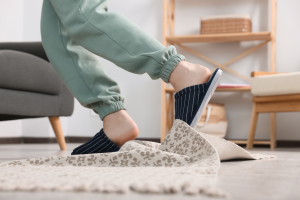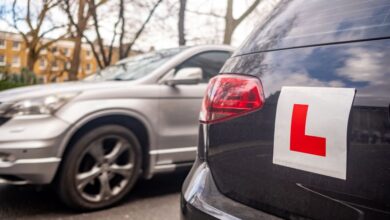Slips and trips risk assessment template

Last Updated on October 6, 2025 by admin
Conducting a slips and trip hazard assessment for a holiday let is essential because it helps protect both you and your guests. By systematically identifying hazards, such as slippery floors, loose carpets, uneven steps, or poorly lit areas, you can take preventive measures to reduce the likelihood of accidents. This not only safeguards your guests’ wellbeing but also reduces the chance of costly legal claims that could be made against you if someone is injured. A risk assessment also demonstrates that you, as the owner, have taken your duty of care seriously, which may strengthen your position with insurers. Bearing this in mind, you may, as a holiday let owner, need to do a formal risk assessment.
It is important to remember that risk assessments are not an ‘end’ in themselves, but a ‘means to one’. They are a first step in preventing slips and trips. Once complete, they should be used to develop safe working practices.
Risk assessment and insurance
Risk assessments are important to insurers. When done properly they identify sensible precautions that, if taken, will prevent accidents in the first place. This reduces the potential for claims, a consideration that can sometimes be reflected in your premium.
Good risk assessments, properly documented, can also assist in the defence of claims. However, in these circumstances they are sometimes shown to be inadequate or poorly developed; identify precautions that are impractical, inadequate or unnecessary; focus on trivial hazards; or completed by those who are not competent.
To discuss Home Insurance for your holiday home, cottage complex, holiday let, or second home, contact us today.
Call: 01237 429 444
Request a Quote: boshers.co.uk/get-your-quote/

Scoring likelihood and severity for trip hazards
Useful resources are available from the Health and Safety Executive (HSE). In most cases for slip and trip hazards, it is difficult to produce reliable, numerical estimates of risk based on probability and severity derived from collated data (e.g. accident data). So, for many, a qualitative approach to the assessment will be more effective. Usually, this will be based on a simple judgment on the adequacy of precautions in the context of statutory requirements and official guidance.
Free HSE risk assessment template
To access HSE’s risk assessment templates to use as a checklist, the HSE website has downloadable templates that you can use for free.
Risk assessment checklist for a holiday let
As a starting point it may be useful to:
- Identify any relevant statutory requirements and other resources (e.g. codes of practice, recognised guidance etc.) that might help identify foreseeable hazards.
- Large properties: decide on the risk assessment approach to be adopted. For larger premises having several buildings, a large estate area, or a wide range of activities, ensuring that risk assessments cover all slip and trips hazards can be difficult. One practical way of approaching this is to divide the estate/premises into areas, completing separate assessments for each that include slips and trips.
- Smaller properties: Even in some smaller premises, it may be easier to consider separate areas one at a time. For events, it may be appropriate to consider slips and trips in a specific event risk assessment as part of broader event safety plan. Where this approach is used, these circumstances should be identified to the best of your ability, and procedures established to ensure that any risk assessment is completed as an integral part of the planning process.
- Review any data or reports of accidents at your premises to identify where slips and trips have been a problem in the past. In some circumstances, it may be possible to map these by marking them on a plan or sketch of the premises to highlight possible ‘hotspots’.
- Walk around or inspect your premises, identifying slip or trip hazards and the precautions in place. In doing this, it might be useful to look at the premises both from an employee and visitor perspective. The simple hazard spotting checklist is available from HSE which you could adapt to your needs.
- Observe how people are using access routes, as they do not always act in a logical manner. This will also help check what happens at the premises.
- Complete your risk assessments, identifying who may be harmed and how, as well as deciding if current precautions are adequate or more needs to be done.
For information on how to insure yourself and your property against third parties injuring themselves at your holiday let, read our blog here: Link to article: Trips, Slips and the Law…
To discuss Home Insurance for your holiday home, cottage complex, holiday let, or second home, contact us today.
Call: 01237 429 444
Request a Quote: boshers.co.uk/get-your-quote/
This guidance is provided for information purposes and is general and educational in nature and does not constitute legal advice. You are free to choose whether or not to use it and it should not be considered a substitute for seeking professional help in specific circumstances.




